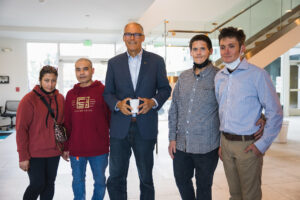75 people previously living unsheltered at I-5 and Dearborn (including the young women pictured above) have been transferred to shelter, lodging, inpatient treatment, and housing resources, thanks to an intensive 6-week collaborative effort.
The resolution is part of Gov. Jay Inslee’s Right of Way Safety Initiative, with funding provided by the state legislature, and implementation through a collaboration between the King County Regional Homelessness Authority, the state Department of Commerce, the Washington State Patrol, the Washington State Department of Transportation, the City of Seattle, and outreach providers PDA (JustCARE) and REACH.
Through this state initiative, state agencies are partnering with local organizations to address the particular risk of people experiencing homelessness on rights of way near active traffic, construction and other dangers. The key to success is strong partnerships with local organizations—such as KCRHA and others—who can work directly with people living unsheltered in these areas.
The key to success is strong partnerships
“I appreciate the incredible dedication of the community organizations and agency teams who have been ensuring we can provide safer options to some of our unhoused neighbors living in dangerous right of way locations,” said Governor Inslee. “This safety initiative is possible because local leaders and experienced nonprofits are willing and able to partner with the state and serve these individuals with compassion.”
“We know that helping people who have complex challenges, including behavioral health needs, requires a trusting relationship,” said Marc Dones, CEO of the King County Regional Homelessness Authority. “Taking the time to understand people’s needs, developing a clear plan to meet those needs, and providing the appropriate housing pathway—that’s what we were able to do for the people living at Dearborn. We provided options that meet people’s needs.”
“Through an intensive six week planning process, with weekly and then daily case conferencing calls, we were able to address the need for health, safety, services, and care. Is there still room for improvement? Of course. But the Authority will continue to work with partners on innovative deployments of best practices to ensure that every person has a place to call home,” said Dones.
Intensive outreach crucial for connecting people to best available housing options
Implementing best practices used by outreach providers PDA (JustCARE) and REACH, and building on some of the successes from Seattle’s Woodland Park encampment resolution, the team deployed intensive engagement over the course of approximately six weeks. KCRHA provider partners were on site daily, building trust and relationships, which then allowed them to conduct the appropriate needs assessments and create personalized case management plans. Regular coordination meetings with state agencies about funding, support and addressing on-site needs kept the progress moving forward.
The goal, as always, is to make sure that people are housed. Great care was taken by the field team to ensure that people living unsheltered at the Dearborn site at the time of assessment were offered dignified and desirable housing and shelter options. For people who relocated to the Dearborn site closer to the final closure date, the KCRHA team worked with the City of Seattle to find available shelter options.
- One woman, age 51 and income-insecure, received medical care and was placed in JustCARE lodging.
- A man in his early 20’s coping with substance use disorder is connected with inpatient treatment and even helped others from the site organize their belongings for storage.
- A 40-year-old mother coping with substance use disorder and the sole caregiver for a wheelchair-bound son is in JustCARE lodging and working on both housing and recovery.
- We worked with the language line to establish a connection with a 57-year-old Cantonese-speaking man, who requested treatment and reunification with his family.
“An intentional, highly-skilled approach that takes the time to understand people and meet their needs is essential,” said Lisa Daugaard, Executive Director at PDA. “We hope that this approach can become the standard regionally, and encourage similar efforts nationally.”
“With the right resources and trusting relationships, we can move people inside,” said Chloe Gale, Program Director at REACH. “It’s hard work, it takes time and cooperation, but it can be done and you can see the results right here.”
The majority of people from the Dearborn site are moving into hotels and other non-congregate shelter with onsite supportive services operated by PDA, and a few have already been placed into permanent housing. The City of Seattle provided shelter spaces at the Navigation Center, Otto’s Place, The Bridge, Jan & Peter’s, and Tiny House Villages. Each person has also been connected with the RHA’s Coordinated Entry and Systems Advocates teams to ensure that they are on a path to permanent housing.
“We know what works to help stem the homelessness crisis, but we need a lot more of it. When people experiencing homelessness are offered a place to go—supportive housing or enhanced shelter that meets people’s needs—they move inside,” said King County Executive Dow Constantine. “Robust engagement paired with services and a safe place to go is a successful strategy, and is central to the collaboration here with the state, city, and partner organizations. When people can connect to services and stay in a place that allows them to rest, heal and take charge of their lives, as happens through the Health Through Housing initiative, we see positive results. King County is proud of this partnership, and I am committed to working with these organizations to make meaningful change—for individuals who are struggling, and for every community.”
“The complexity of the homelessness crisis requires collaboration to deliver effective solutions” said Seattle Mayor Bruce Harrell. “While no jurisdiction, authority, or non-profit can solve it all alone, effective resolution efforts like this demonstrate we can make progress when we align on our mission and values. Working together, we can get people off the streets with the support, services, shelter, and housing they need for safety, stability, and recovery.”
Initiative focuses on safer options for people experiencing homelessness
The right of way locations involved in this initiative are not safe places for anyone to live, and finding safe and stable housing for people experiencing homelessness is a priority for Gov. Inslee and the state Legislature. The state has made significant funding available through the Department of Commerce. To support this effort, the state has already provided $13.8 million in state funds for this first round of encampment work in King County ($144 million total statewide), and will provide additional funding for similar encampment resolutions this year, with additional state funding available in the years to come.
In addition to the Dearborn site, the collaboration has already resolved two encampments, one at I-5 and Olive Way, and another at the I-5 and 520 interchange, with a similar approach of intensive outreach followed by placement in dignified and desirable housing and shelter options.
Homelessness is a challenging and complex issue that can only be effectively addressed through collaboration across many partners, including state and local governments and outreach and nonprofit groups, working together to implement best practices.
After resolution, and with people safely relocated to shelter and housing options, WSDOT can then modify sites with fencing or other options to prevent others from moving to rights of way and being exposed to the inherent safety risks these sites present.



